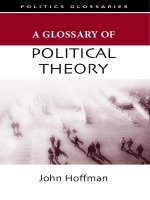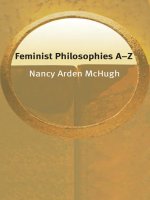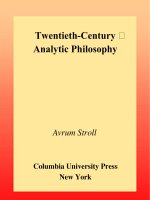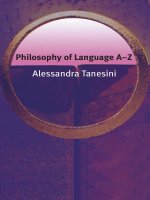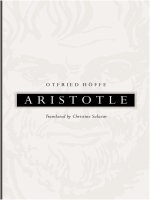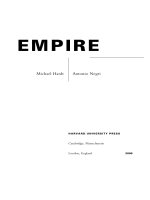harvard university press empire mar 2000
Bạn đang xem bản rút gọn của tài liệu. Xem và tải ngay bản đầy đủ của tài liệu tại đây (1.35 MB, 494 trang )
EMPIRE
Michael Hardt Antonio Negri
HARVARD UNIVERSITY PRESS
Cambridge, Massachusetts
London, England
2000
Copyright ᭧ 2000 by the President and Fellows of Harvard College
All rights reserved
Printed in the United States of America
First Harvard University Press paperback edition, 2001
Library of Congress Cataloging-in-Publication Data
Hardt, Michael.
Empire / Michael Hardt and Antonio Negri.
p. cm.
Includes bibliographical references and index.
ISBN 0-674-25121-0 (cloth)
ISBN 0-674-00671-2 (pbk.)
1. Imperialism. I. Negri, Antonio, 1933– . II. Title.
JC359.H279 2000
325Ј.32Ј09045—dc21 99-39619
Fourth printing, 2001
Every tool is a weapon if you hold it right.
Ani DiFranco
Men fight and lose the battle, and the thing that they fought for
comes about in spite of their defeat, and then it turns out not to be
what they meant, and other men have to fight for what they meant
under another name.
William Morris
ACKNOWLEDGMENTS
We would like to thank the friends and colleagues
who read parts of this manuscript and from whose comments we
benefited: Robert Adelman, E
´
tienne Balibar, Denis Berger, Yann
Moulier Boutang, Tom Conley, Arif Dirlik, Luciano Ferrari-
Bravo, David Harvey, Fred Jameson, Rebecca Karl, Wahneema
Lubiano, Saree Makdisi, Christian Marazzi, Valentin Mudimbe,
Judith Revel, Ken Surin, Christine Thorsteinsson, Jean-Marie
Vincent, Paolo Virno, Lindsay Waters, and Kathi Weeks.
The quote by Ani DiFranco on page v is from ‘‘My IQ,’’
copyright ᭧ 1993 Righteous Babe Music, all rights reserved, and
is used by permission.
CONTENTS
Preface xi
PART 1
The Political Constitution of the Present
1
1.1 World Order 3
1.2 Biopolitical Production 22
1.3 Alternatives within Empire 42
PART 2
Passages of Sovereignty
67
2.1 Two Europes, Two Modernities 69
2.2 Sovereignty of the Nation-State 93
2.3 The Dialectics of Colonial Sovereignty 114
2.4 Symptoms of Passage 137
2.5 Network Power: U.S. Sovereignty and the New Empire 160
2.6 Imperial Sovereignty 183
INTERMEZZO: COUNTER-EMPIRE
205
PART 3
Passages of Production
219
3.1 The Limits of Imperialism 221
3.2 Disciplinary Governability 240
3.3 Resistance, Crisis, Transformation 260
3.4 Postmodernization, or The Informatization of Production 280
3.5 Mixed Constitution 304
3.6 Capitalist Sovereignty, or Administering the Global
Society of Control 325
x CONTENTS
PART 4
The Decline and Fall of Empire
351
4.1 Virtualities 353
4.2 Generation and Corruption 370
4.3 The Multitude against Empire 393
Notes 415
Index 473
PREFACE
Empire is materializing before our very eyes. Over the
past several decades, as colonial regimes were overthrown and then
precipitously after the Soviet barriers to the capitalist world market
finally collapsed, we have witnessed an irresistible and irreversible
globalization of economic and cultural exchanges. Along with the
global market and global circuits of production has emerged a global
order, a new logic and structure of rule—in short, a new form of
sovereignty. Empire is the political subject that effectively regulates
these global exchanges, the sovereign power that governs the world.
Many argue that the globalization of capitalist production and
exchange means that economic relations have become more autono-
mous from political controls, and consequently that political sover-
eignty has declined. Some celebrate this new era as the liberation
of the capitalist economy from the restrictions and distortions that
political forces have imposed on it; others lament it as the closing
of the institutional channels through which workers and citizens
can influence or contest the cold logic of capitalist profit. It is
certainly true that, in step with the processes of globalization, the
sovereignty of nation-states, while still effective, has progressively
declined. The primary factors of production and exchange—
money, technology, people, and goods—move with increasing ease
across national boundaries; hence the nation-state has less and less
power to regulate these flows and impose its authority over the
economy. Even the most dominant nation-states should no longer
be thought of as supreme and sovereign authorities, either outside
or even within their own borders. The decline in sovereignty of nation-
states, however, does not mean that sovereignty as such has declined.
1
xii PREFACE
Throughout the contemporary transformations, political controls,
state functions, and regulatory mechanisms have continued to rule
the realm of economic and social production and exchange. Our
basic hypothesis is that sovereignty has taken a new form, composed
of a series of national and supranational organisms united under a
single logic of rule. This new global form of sovereignty is what
we call Empire.
The declining sovereignty of nation-states and their increasing
inability to regulate economic and cultural exchanges is in fact one
of the primary symptoms of the coming of Empire. The sovereignty
of the nation-state was the cornerstone of the imperialisms that
European powers constructed throughout the modern era. By ‘‘Em-
pire,’’ however, we understand something altogether different from
‘‘imperialism.’’ The boundaries defined by the modern system of
nation-states were fundamental to European colonialism and eco-
nomic expansion: the territorial boundaries of the nation delimited
the center of power from which rule was exerted over external
foreign territories through a system of channels and barriers that
alternately facilitated and obstructed the flows of production and
circulation. Imperialism was really an extension of the sovereignty
of the European nation-states beyond their own boundaries. Even-
tually nearly all the world’s territories could be parceled out and
the entire world map could be coded in European colors: red for
British territory, blue for French, green for Portuguese, and so
forth. Wherever modern sovereignty took root, it constructed a
Leviathan that overarched its social domain and imposed hierarchical
territorial boundaries, both to police the purity of its own identity
and to exclude all that was other.
The passage to Empire emerges from the twilight of modern
sovereignty. In contrast to imperialism, Empire establishes no terri-
torial center of power and does not rely on fixed boundaries or
barriers. It is a decentered and deterritorializing apparatus of rule that
progressively incorporates the entire global realm within its open,
expanding frontiers. Empire manages hybrid identities, flexible hier-
archies, and plural exchanges through modulating networks of com-
PREFACE xiii
mand. The distinct national colors of the imperialist map of the
world have merged and blended in the imperial global rainbow.
The transformation of the modern imperialist geography of
the globe and the realization of the world market signal a passage
within the capitalist mode of production. Most significant, the
spatial divisions of the three Worlds (First, Second, and Third) have
been scrambled so that we continually find the First World in the
Third, the Third in the First, and the Second almost nowhere at
all. Capital seems to be faced with a smooth world—or really, a
world defined by new and complex regimes of differentiation and
homogenization, deterritorialization and reterritorialization. The
construction of the paths and limits of these new global flows has
been accompanied by a transformation of the dominant productive
processes themselves, with the result that the role of industrial factory
labor has been reduced and priority given instead to communicative,
cooperative, and affective labor. In the postmodernization of the
global economy, the creation of wealth tends ever more toward
what we will call biopolitical production, the production of social
life itself, in which the economic, the political, and the cultural
increasingly overlap and invest one another.
Many locate the ultimate authority that rules over the processes
of globalization and the new world order in the United States.
Proponents praise the United States as the world leader and sole
superpower, and detractors denounce it as an imperialist oppressor.
Both these views rest on the assumption that the United States has
simply donned the mantle of global power that the European nations
have now let fall. If the nineteenth century was a British century,
then the twentieth century has been an American century; or really,
if modernity was European, then postmodernity is American. The
most damning charge critics can level, then, is that the United
States is repeating the practices of old European imperialists, while
proponents celebrate the United States as a more efficient and more
benevolent world leader, getting right what the Europeans got
wrong. Our basic hypothesis, however, that a new imperial form
of sovereignty has emerged, contradicts both these views. The United
xiv PREFACE
States does not, and indeed no nation-state can today, form the center of
an imperialist project. Imperialism is over. No nation will be world
leader in the way modern European nations were.
The United States does indeed occupy a privileged position
in Empire, but this privilege derives not from its similarities to the
old European imperialist powers, but from its differences. These
differences can be recognized most clearly by focusing on the prop-
erly imperial (not imperialist) foundations of the United States
constitution, where by ‘‘constitution’’ we mean both the formal
constitution, the written document along with its various amend-
ments and legal apparatuses, and the material constitution, that is, the
continuous formation and re-formation of the composition of social
forces. Thomas Jefferson, the authors of the Federalist, and the other
ideological founders of the United States were all inspired by the
ancient imperial model; they believed they were creating on the
other side of the Atlantic a new Empire with open, expanding
frontiers, where power would be effectively distributed in networks.
This imperial idea has survived and matured throughout the history
of the United States constitution and has emerged now on a global
scale in its fully realized form.
We should emphasize that we use ‘‘Empire’’ here not as a
metaphor, which would require demonstration of the resemblances
between today’s world order and the Empires of Rome, China,
the Americas, and so forth, but rather as a concept, which calls
primarily for a theoretical approach.
2
The concept of Empire is
characterized fundamentally by a lack of boundaries: Empire’s rule
has no limits. First and foremost, then, the concept of Empire posits
a regime that effectively encompasses the spatial totality, or really
that rules over the entire ‘‘civilized’’ world. No territorial boundaries
limit its reign. Second, the concept of Empire presents itself not as
a historical regime originating in conquest, but rather as an order
that effectively suspends history and thereby fixes the existing state
of affairs for eternity. From the perspective of Empire, this is the
way things will always be and the way they were always meant to
be. In other words, Empire presents its rule not as a transitory
PREFACE xv
moment in the movement of history, but as a regime with no
temporal boundaries and in this sense outside of history or at the
end of history. Third, the rule of Empire operates on all registers
of the social order extending down to the depths of the social
world. Empire not only manages a territory and a population but
also creates the very world it inhabits. It not only regulates human
interactions but also seeks directly to rule over human nature. The
object of its rule is social life in its entirety, and thus Empire presents
the paradigmatic form of biopower. Finally, although the practice
of Empire is continually bathed in blood, the concept of Empire
is always dedicated to peace—a perpetual and universal peace out-
side of history.
The Empire we are faced with wields enormous powers of
oppression and destruction, but that fact should not make us nostal-
gic in any way for the old forms of domination. The passage to
Empire and its processes of globalization offer new possibilities to
the forces of liberation. Globalization, of course, is not one thing,
and the multiple processes that we recognize as globalization are
not unified or univocal. Our political task, we will argue, is not
simply to resist these processes but to reorganize them and redirect
them toward new ends. The creative forces of the multitude that
sustain Empire are also capable of autonomously constructing a
counter-Empire, an alternative political organization of global flows
and exchanges. The struggles to contest and subvert Empire, as
well as those to construct a real alternative, will thus take place on
the imperial terrain itself—indeed, such new struggles have already
begun to emerge. Through these struggles and many more like
them, the multitude will have to invent new democratic forms and
a new constituent power that will one day take us through and
beyond Empire.
The genealogy we follow in our analysis of the passage from
imperialism to Empire will be first European and then Euro-
American, not because we believe that these regions are the exclu-
sive or privileged source of new ideas and historical innovation,
but simply because this was the dominant geographical path along
xvi PREFACE
which the concepts and practices that animate today’s Empire devel-
oped—in step, as we will argue, with the development of the
capitalist mode of production.
3
Whereas the genealogy of Empire
is in this sense Eurocentric, however, its present powers are not
limited to any region. Logics of rule that in some sense originated
in Europe and the United States now invest practices of domination
throughout the globe. More important, the forces that contest
Empire and effectively prefigure an alternative global society are
themselves not limited to any geographical region. The geography
of these alternative powers, the new cartography, is still waiting to be
written—or really, it is being written today through the resistances,
struggles, and desires of the multitude.
In writing this book we have tried to the best of our
abilities to employ a broadly interdisciplinary approach.
4
Our argu-
ment aims to be equally philosophical and historical, cultural and
economic, political and anthropological. In part, our object of study
demands this broad interdisciplinarity, since in Empire the bound-
aries that might previously have justified narrow disciplinary ap-
proaches are increasingly breaking down. In the imperial world
the economist, for example, needs a basic knowledge of cultural
production to understand the economy, and likewise the cultural
critic needs a basic knowledge of economic processes to understand
culture. That is a requirement that our project demands. What we
hope to have contributed in this book is a general theoretical
framework and a toolbox of concepts for theorizing and acting in
and against Empire.
5
Like most large books, this one can be read in many different
ways: front to back, back to front, in pieces, in a hopscotch pattern,
or through correspondences. The sections of Part 1 introduce the
general problematic of Empire. In the central portion of the book,
Parts 2 and 3, we tell the story of the passage from modernity to
postmodernity, or really from imperialism to Empire. Part 2 narrates
the passage primarily from the standpoint of the history of ideas
and culture from the early modern period to the present. The red
PREFACE xvii
thread that runs throughout this part is the genealogy of the concept
of sovereignty. Part 3 narrates the same passage from the standpoint
of production, whereby production is understood in a very broad
sense, ranging from economic production to the production of
subjectivity. This narrative spans a shorter period and focuses primar-
ily on the transformations of capitalist production from the late
nineteenth century to the present. The internal structures of Parts
2 and 3 thus correspond: the first sections of each treat the modern,
imperialist phase; the middle sections deal with the mechanisms of
passage; and the final sections analyze our postmodern, imperial
world.
We structured the book this way in order to emphasize the
importance of the shift from the realm of ideas to that of production.
The Intermezzo between Parts 2 and 3 functions as a hinge that
articulates the movement from one standpoint to the other. We
intend this shift of standpoint to function something like the mo-
ment in Capital when Marx invites us to leave the noisy sphere of
exchange and descend into the hidden abode of production. The
realm of production is where social inequalities are clearly revealed
and, moreover, where the most effective resistances and alternatives
to the power of Empire arise. In Part 4 we thus try to identify
these alternatives that today are tracing the lines of a movement
beyond Empire.
This book was begun well after the end of the Persian
Gulf War and completed well before the beginning of the war in
Kosovo. The reader should thus situate the argument at the midpoint
between those two signal events in the construction of Empire.
PART
1
THE POLITICAL CONSTITUTION
OF THE PRESENT
1.1
WORLD ORDER
Capitalism only triumphs when it becomes identified with the state,
when it is the state.
Fernand Braudel
They make slaughter and they call it peace.
Tacitus
The problematic of Empire is determined in the first
place by one simple fact: that there is world order. This order is
expressed as a juridical formation. Our initial task, then, is to grasp
the constitution of the order being formed today. We should rule
out from the outset, however, two common conceptions of this
order that reside on opposing limits of the spectrum: first, the notion
that the present order somehow rises up spontaneously out of the
interactions of radically heterogeneous global forces, as if this order
were a harmonious concert orchestrated by the natural and neutral
hidden hand of the world market; and second, the idea that order
is dictated by a single power and a single center of rationality
transcendent to global forces, guiding the various phases of historical
development according to its conscious and all-seeing plan, some-
thing like a conspiracy theory of globalization.
1
United Nations
Before investigating the constitution of Empire in juridical terms,
we must analyze in some detail the constitutional processes that
have come to define the central juridical categories, and in particular
4 THE POLITICAL CONSTITUTION OF THE PRESENT
give careful attention to the process of the long transition from the
sovereign right of nation-states (and the international right that
followed from it) to the first postmodern global figures of imperial
right. As a first approximation one can think of this as the genealogy
of juridical forms that led to, and now leads beyond, the suprana-
tional role of the United Nations and its various affiliated institu-
tions.
It is widely recognized that the notion of international order
that European modernity continually proposed and reproposed, at
least since the Peace of Westphalia, is now in crisis.
2
It has in fact
always been in crisis, and this crisis has been one of the motors that
has continuously pushed toward Empire. Perhaps this notion of
international order and its crisis should be dated from the time of
the Napoleonic Wars, as some scholars claim, or perhaps the origin
should be located in the Congress of Vienna and the establishment
of the Holy Alliance.
3
In any case, there can be no doubt that by
the time of the First World War and the birth of the League of
Nations, a notion of international order along with its crisis had
been definitively established. The birth of the United Nations at
the end of the Second World War merely reinitiated, consolidated,
and extended this developing international juridical order that was
first European but progressively became completely global. The
United Nations, in effect, can be regarded as the culmination of
this entire constitutive process, a culmination that both reveals the
limitations of the notion of international order and points beyond
it toward a new notion of global order. One could certainly analyze
the U.N. juridical structure in purely negative terms and dwell on
the declining power of nation-states in the international context,
but one should also recognize that the notion of right defined by
the U.N. Charter also points toward a new positive source of
juridical production, effective on a global scale—a new center of
normative production that can play a sovereign juridical role. The
U.N. functions as a hinge in the genealogy from international
to global juridical structures. On the one hand, the entire U.N.
conceptual structure is predicated on the recognition and legitima-
WORLD ORDER 5
tion of the sovereignty of individual states, and it is thus planted
squarely within the old framework of international right defined
by pacts and treaties. On the other hand, however, this process of
legitimation is effective only insofar as it transfers sovereign right
to a real supranational center. It is not our intention here to criticize
or lament the serious (and at times tragic) inadequacies of this
process; indeed, we are interested in the United Nations and the
project of international order not as an end in itself, but rather as
a real historical lever that pushed forward the transition toward a
properly global system. It is precisely the inadequacies of the process,
then, that make it effective.
To look more closely at this transition in juridical terms, it is
useful to read the work of Hans Kelsen, one of the central intellectual
figures behind the formation of the United Nations. As early as the
1910s and 1920s, Kelsen proposed that the international juridical
system be conceived as the supreme source of every national juridical
formation and constitution. Kelsen arrived at this proposal through
his analyses of the formal dynamics of the particular orderings of
states. The limits of the nation-state, he claimed, posed an insur-
mountable obstacle to the realization of the idea of right. For Kelsen,
the partial ordering of the domestic law of nation-states led back
necessarily to the universality and objectivity of the international
ordering. The latter is not only logical but also ethical, for it would
put an end to conflicts between states of unequal power and affirm
instead an equality that is the principle of real international commu-
nity. Behind the formal sequence that Kelsen described, then, there
was a real and substantial drive of Enlightenment modernization.
Kelsen sought, in Kantian fashion, a notion of right that could
become an ‘‘organization of humanity and [would] therefore be
one with the supreme ethical idea.’’
4
He wanted to get beyond the
logic of power in international relations so that ‘‘the particular states
could be regarded juridically as entities of equal rank’’ and thus a
‘‘world and universal state’’ could be formed, organized as a ‘‘univer-
sal community superior to the particular states, enveloping them
all within itself.’’
5
6 THE POLITICAL CONSTITUTION OF THE PRESENT
It was only fitting, then, that Kelsen would later have the
privilege of attending the meetings in San Francisco that founded
the United Nations and seeing his theoretical hypothesis realized.
For him the United Nations organized a rational idea.
6
It gave legs
to an idea of the spirit; it proposed a real base of effectiveness for
a transcendental schema of the validity of right situated above the
nation-state. The validity and efficacy of right could now be united
in the supreme juridical source, and under these conditions Kelsen’s
notion of a fundamental norm could finally be realized.
Kelsen conceived the formal construction and validity of the
system as independent from the material structure that organizes it,
but in reality the structure must somehow exist and be organized
materially. How can the system actually be constructed? This is the
point at which Kelsen’s thought ceases to be of any use to us: it
remains merely a fantastic utopia. The transition we wish to study
consists precisely in this gap between the formal conception that
grounds the validity of the juridical process in a supranational source
and the material realization of this conception. The life of the
United Nations, from its foundation to the end of the cold war, has
been a long history of ideas, compromises, and limited experiences
oriented more or less toward the construction of such a supranational
ordering. The aporias of this process are obvious, and there is no
need for us to describe them in detail here. Certainly the United
Nations’ domination of the general framework of the supranational
project between 1945 and 1989 led to some of the most perverse
theoretical and practical consequences. And yet, all this was not
enough to block the constitutionalization of a supranational power.
7
In the ambiguous experiences of the United Nations, the juridical
concept of Empire began to take shape.
The theoretical responses to this constitutionalization of a
supranational world power, however, have been entirely inade-
quate. Instead of recognizing what was really new about these
supranational processes, the vast majority of juridical theorists merely
tried to resurrect anachronistic models to apply to the new problems.
To a large extent, in fact, the models that had presided over the
WORLD ORDER 7
birth of the nation-state were simply dusted off and reproposed as
interpretive schema for reading the construction of a supranational
power. The ‘‘domestic analogy’’ thus became the fundamental meth-
odological tool in the analysis of international and supranational
forms of order.
8
Two lines of thought have been particularly active
during this transition, and as a kind of shorthand we can conceive
of them as resurrections of the Hobbesian and the Lockean ideolo-
gies that in another era dominated the European conceptions of
the sovereign state.
The Hobbesian variant focuses primarily on the transfer of the
title of sovereignty and conceives the constitution of the supra-
national sovereign entity as a contractual agreement grounded on
the convergence of preexisting state subjects.
9
A new transcendent
power, ‘‘tertium super partes,’’ primarily concentrated in the hands
of the military (the one that rules over life and death, the Hobbesian
‘‘God on earth’’), is, according to this school, the only means capable
of constituting a secure international system and thus of overcoming
the anarchy that sovereign states necessarily produce.
10
By contrast,
according to the Lockean variant, the same process is projected in
more decentralized, pluralistic terms. In this framework, just when
the transfer toward a supranational center is accomplished, networks
of local and constitutionally effective counterpowers rise up to
contest and/or support the new figure of power. Rather than global
security, then, what is proposed here is a global constitutionalism,
or really this amounts to a project of overcoming state imperatives
by constituting a global civil society. These slogans are meant to evoke
the values of globalism that would infuse the new international
order, or really the new transnational democracy.
11
Whereas the
Hobbesian hypothesis emphasizes the contractual process that gives
rise to a new unitary and transcendental supranational power, the
Lockean hypothesis focuses on the counterpowers that animate the
constitutive process and support the supranational power. In both
cases, however, the new global power is presented merely in analogy
with the classical conception of the national sovereign power of
states. Rather than recognizing the new nature of imperial power,
8 THE POLITICAL CONSTITUTION OF THE PRESENT
the two hypotheses simply insist on the old inherited forms of state
constitution: a monarchic form in the Hobbesian case, a liberal
form in the Lockean.
Although, given the conditions in which these theories were
formulated (during the cold war, when the United Nations only
limped forward in the best of times), we must recognize the great
foresight of these theorists, we also have to point out that they
cannot account for the real novelty of the historical processes we
are witnessing today.
12
In this regard these theories can and do
become harmful, because they do not recognize the accelerated
rhythm, the violence, and the necessity with which the new imperial
paradigm operates. What they do not understand is that imperial sover-
eignty marks a paradigm shift. Paradoxically (but it is really not that
paradoxical), only Kelsen’s conception poses the real problem, even
if his conception is limited to a strictly formalist point of view.
What political power already exists or can be created, he asks, that
is adequate to a globalization of economic and social relations?
What juridical source, what fundamental norm, and what command
can support a new order and avoid the impending descent into
global disorder?
The Constitution of Empire
Many contemporary theorists are reluctant to recognize the global-
ization of capitalist production and its world market as a fundamen-
tally new situation and a significant historical shift. The theorists
associated with the world-systems perspective, for example, argue
that from its inception, capitalism has always functioned as a world
economy, and therefore those who clamor about the novelty of its
globalization today have only misunderstood its history.
13
Certainly,
it is important to emphasize both capitalism’s continuous founda-
tional relationship to (or at least a tendency toward) the world
market and capitalism’s expanding cycles of development; but
proper attention to the ab origine universal or universalizing dimen-
sions of capitalist development should not blind us to the rupture
or shift in contemporary capitalist production and global relations
WORLD ORDER 9
of power. We believe that this shift makes perfectly clear and possible
today the capitalist project to bring together economic power and
political power, to realize, in other words, a properly capitalist
order. In constitutional terms, the processes of globalization are no
longer merely a fact but also a source of juridical definitions that
tends to project a single supranational figure of political power.
Other theorists are reluctant to recognize a major shift in global
power relations because they see that the dominant capitalist nation-
states have continued to exercise imperialist domination over the
other nations and regions of the globe. From this perspective, the
contemporary tendencies toward Empire would represent not a
fundamentally new phenomenon but simply a perfecting of imperi-
alism.
14
Without underestimating these real and important lines of
continuity, however, we think it is important to note that what
used to be conflict or competition among several imperialist powers
has in important respects been replaced by the idea of a single power
that overdetermines them all, structures them in a unitary way, and
treats them under one common notion of right that is decidedly
postcolonial and postimperialist. This is really the point of departure
for our study of Empire: a new notion of right, or rather, a new
inscription of authority and a new design of the production of
norms and legal instruments of coercion that guarantee contracts
and resolve conflicts.
We should point out here that we accord special attention to
the juridical figures of the constitution of Empire at the beginning
of our study not out of any specialized disciplinary interest—as if
right or law in itself, as an agent of regulation, were capable of
representing the social world in its totality—but rather because they
provide a good index of the processes of imperial constitution. New
juridical figures reveal a first view of the tendency toward the
centralized and unitary regulation of both the world market and
global power relations, with all the difficulties presented by such a
project. Juridical transformations effectively point toward changes
in the material constitution of world power and order. The transition
we are witnessing today from traditional international law, which
